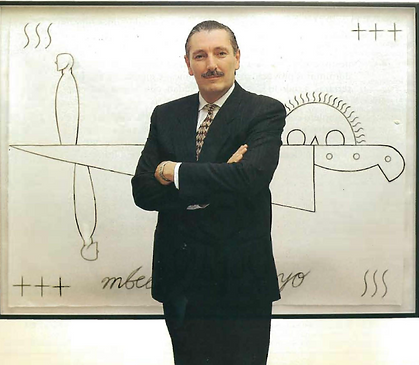
Vogue Espana, Miami Edition
Author: Claudia Dobkin
View PDF of original article
inspiration//
fernando
Being with Fernando is being for the love of art.
Doctor. Intellectual. Patron of the arts. Fernando Alvarez Perez has only one goal: Support the new generation of Cuban artists.
In his 1930s house in Coral Gables, a few steps from the elegant Biltmore Hotel, Fernando Álvarez Pérez introduces the visitor to the magic of contemporary Cuban art. His imposing presence, nearly two meters tall, captivates with his passion for Cuban artists and the great humility with which he describes his role. Born in Cuba, into a renowned family, he was raised in Mexico, Costa Rica, and the United States. When his intellectual curiosity reached its peak, he moved to Spain, where he studied medicine and immersed himself in European culture. The result: elegance, nobility of spirit, and a contagious passion for art.
Art is present in all facets of his life. His desk is filled with exhibition catalogs, books, and personal writings. Portraits of his wife and children, and works by world-renowned artists such as José Bedia, Luis Cruz Azaceta, Rubén Torres Llorca, Rogelio López Marín (Gory), Carlos Rodríguez Cárdenas, Tomás Esson, and Carlos Alfonso, fill almost the entire house.
Fernando began collecting Latin American art in 1980, and in 1987 he turned to contemporary Cuban painting. Just because he is Cuban? "First and foremost, I collect contemporary art; art that has to do with my experience as a human being. Of course, as a Cuban, I feel a personal connection with the theme of exile and also with the role I can play as an advocate for these artists. For many years, I have felt more on a plane than in a house. This collection explains my experience and legitimizes it."
In the early eighties, painters like Bedia, Elso, Torres Llorca, and others began to explore new artistic expressions. Their work, along with that of eight other creators, was included in an exhibition called Volumen I, which opened in January 1981 at the International Art Center of Havana. The exhibition determined the emergence of a new art in Cuba. Artists of subsequent generations have gone a step further. Young artists like Florencio Gelabert, Esson, and Cárdenas have successfully developed their careers in the United States, transcending the principles of the New York school, and they embrace and transform the motifs of their predecessors: oppression and lack of identity. The doctor Álvarez's collection includes paintings and sculptures that represent each of the phases of this movement. In recognition of this artistic current, the Center for Fine Arts in Miami now gives more space to contemporary Latin American art—especially Cuban art—in its exhibitions, and has named Dr. Álvarez Pérez a member of its board. A doctor turned patron, for the love of art.